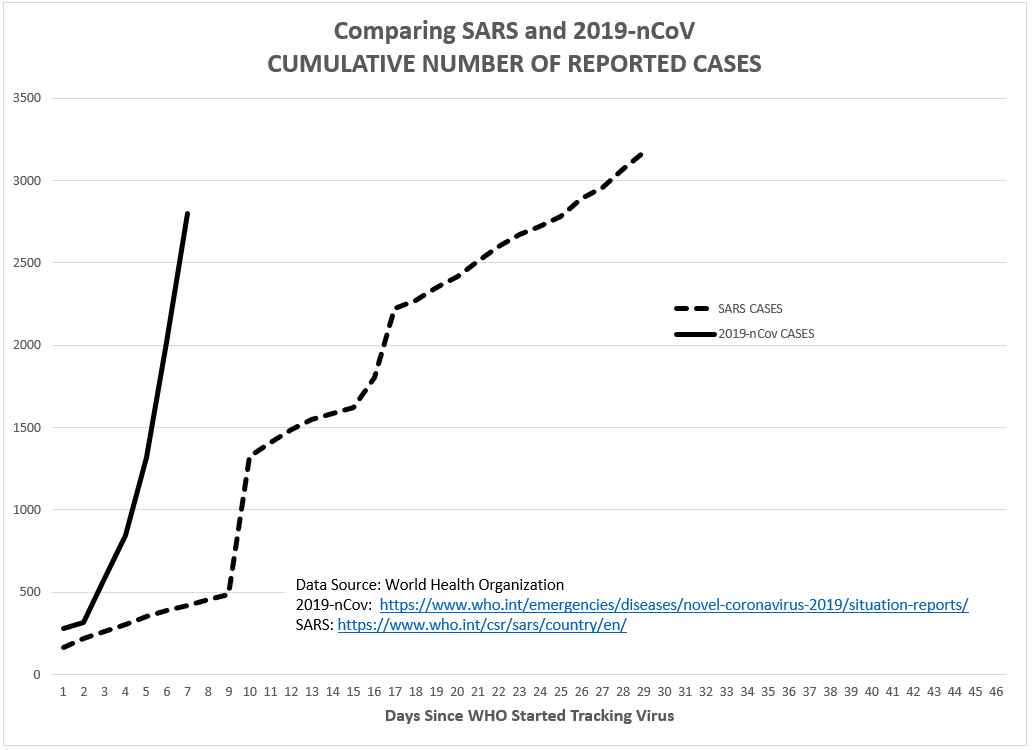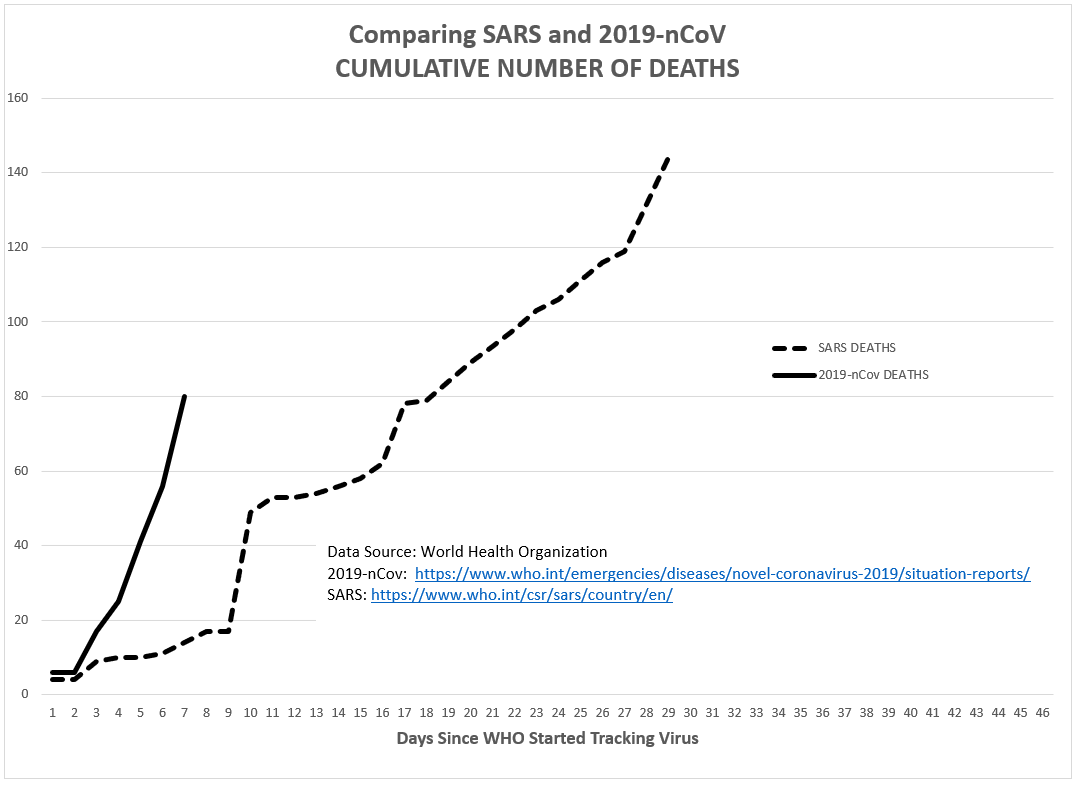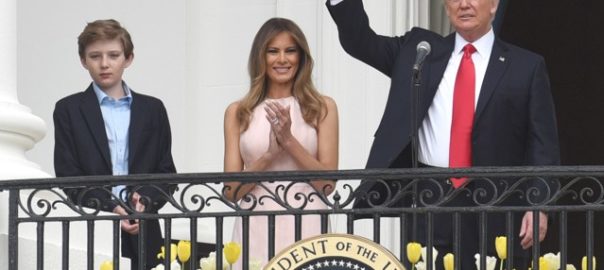By Kent R. Kroeger (NuQum.com, January 29, 2020)
Last Sunday night, CNN’s Dr. Sanjay Gupta comforted his audience by noting that this season’s common flu is a far deadlier to Americans than the Wuhan coronavirus — known as 2019-nCov — which is still concentrated mostly in China.
Similarly, on NPR’s Morning Edition on Monday, a Chinese epidemiologist comforted listeners by noting that 2019-nCov was not as lethal as 2003’s severe acute respiratory syndrome (SARS) coronavirus which killed 774 people worldwide and infected 8,098 people.
When asked yesterday on the The Hill’s Rising podcast, hosted by Krystal Ball and Saagar Enjeti, about whether Americans should be worried about 2019-nCov, former CDC Director Dr. Tom Frieden was slightly more alarmist:
“This is a very serious outbreak. It is spreading widely. It appears to be more infectious than the SARS virus was in 2003 and, though it is somewhat less deadly so far than SARS, it is still far more deadly than a mild virus.”
Somewhat less deadly than SARS? Far more deadly than a mild virus? You can be forgiven if you are not sure how concerned you need to be about 2019-nCov. With only 5 known cases in the U.S. — and no deaths, so far — I would not blame any American for ignoring this newest pandemic scare.
But that might be a mistake in this case. The data on 2019-nCov being released daily by the World Health Organization (WHO) is forming a picture of the virus that is trending in a direction significantly more serious than SARS. Figures 1 and 2 (below) show the current trajectory of 2019-nCov relative to SARS in terms of reported cases and fatalities. Each data series plotted below start from the date WHO started tracking these viruses on their public website.
As you can see, from Day 1 both viruses start from a similar position, but over the course of 2019-nCov’s first week it is already significantly higher than SARS in reported cases (2,798 versus 421) and fatalities (80 versus 14).
Figure 1: Comparing SARS and 2019-nCov (Reported Cases)

Figure 2: Comparing SARS and 2019-nCov (Fatalities)

Admittedly, we only have one week of data for 2019-nCov and many factors that will determine its final outcome are yet to be determined (e.g., vaccine, effectiveness of gov’t intervention programs, etc.). Moreover, the WHO could be getting these higher numbers for 2019-nCov because of China’s experience with SARS which may have led to improved, faster diagnostic methods and a higher propensity among individuals with symptoms to receive immediate medical care.
That would be the good news story. The bad news story would be that the steeper trajectory for 2019-nCov — even at this early stage — is indicative of a much more infectious virus than SARS that will, despite having a lower mortality rate, potentially kill far more people.
Already, as of 29 January 2020, Johns Hopkins researchers are reporting 6,057 confirmed cases of 2019-nCov and 132 confirmed deaths on their daily tracking website — which tends to be more up-to-date than the WHO daily situation report. If the Johns Hopkins numbers are accurate, 2019-nCov has already infected 75 percent of the final infection number for SARS, and while 2019-nCov has a long way to go to reach SARS’ fatality numbers, at the current pace 2019-nCov will reach it in 6 to 7 weeks.
_________________________________________________________________
My intent is not to trigger excessive alarm over 2019-nCov. At this early juncture, it does not look like a major pandemic on the scale of the Spanish Flu of 1918–1919 — which killed 50 million people worldwide — or even the Hong Kong Flu of 1968–1969 that killed 1 million people worldwide, including 34, 000 in the U.S.
In fact, the national and international news media should be commended for their restraint in covering 2019-nCov — at least for now. That most of the news stories so far acknowledge the early nature of this current outbreak and make a strong effort to put it into historical context is a positive reflection on the journalists covering the story.
For example, CNN’s Dr. Gupta saying the current common flu season is a bigger threat to American lives than 2019-nCov is an important comparison. This U.S. flu season alone (2019–2020), the low estimate is that over 8,200 people have already died and 140,000 have been hospitalized, according the Center for Disease Control. Furthermore, at least 15,000,000 million people have contracted the flu and between 7 and 10 million have visited a doctor for the flu. These numbers still dwarf anything related to 2019-nCov. [Quick math: The U.S. mortality rate so far for this flu season is 8,200 divided by 15,000,000…or around 55 deaths for every 100,000 flu cases.]
But Dr. Gupta’s calming assurance that 2019-nCov isn’t an immediate, dire threat also runs the risk of making the general public too complacent at the exact time they should be taking precautions (e.g., cancel travel plans to highly-infected areas, limit interactions with people recently traveling in those areas, etc.).
Of course, it may already be too late to change the trajectory of 2019-nCov as its die may have been cast.
_________________________________________________________________
How bad could 2019-nCov get?
Epidemiologists rightfully exercise caution when citing any single number regarding the lethality of 2019-nCov. Viruses can evolve during a single outbreak and later mortality rates can differ significantly from earlier rates.
But we do have early mortality estimates for 2019-nCov. As of 27 January 2020, the WHO reported 2,798 confirmed cases of 2019-nCov and 80 deaths, which is a 3 percent mortality rate. However, according to Anthony Fauci, director of the U.S. National Institute of Allergy and Infectious Diseases in Bethesda, M.D., this is likely an over-estimate as it is hard to know how many people currently have the virus but are not showing symptoms or have not received medical attention.
In comparison, SARS had a mortality rate of 10 percent (8,098 confirmed cases with 774 people dying) and the Middle East respiratory syndrome (MERS), since 2012, has 2,494 confirmed cases and has killed 858 people (a 34 percent mortality rate!). Interestingly, MERS is still active with 12 new cases diagnosed in November 2019.
The deadliest flu virus of the past two centuries was the Spanish Flu pandemic of 1918–1919 that killed 50 million people worldwide with an estimated mortality rate of between 10 and 20 percent. What made the Spanish Flu so deadly was its infection rate of around 50 percent (# of those infected / Population Size).
In contrast, per Johns Hopkins infection numbers, the current 2019-nCov infection rate in China’s Hubei province is about 10 infections for every 100,000 people. Of course, this cumulative number is going to move up (probably dramatically) in the next few months. The point is simply that 2019-nCov is not even near the magnitude of the Spanish Flu. In fact, it is substantially less infectious than the common flu viruses now spreading across the U.S., which have a current combined infection rate of 4 percent That number will also rise over time as we are only half way through this year’s flu season.
Outside of the coronaviruses, the average Ebola virus outbreak has a mortality rate of around 50 percent, according to the WHO. Most recently, the 2014–2016 Ebola outbreak that hit primarily West Africa generated 28,652 confirmed cases and caused 11,325 fatalities (a 40 percent mortality rate).
So there you go — 2019-nCov isn’t Ebola or the Spanish Flu, so rest easy.
Well, not so fast. Given that the China’s National Health Commission Minister, Ma Xiaowei, said on Sunday that the incubation period for 2019-nCoV could range from one to 14 days, it is obvious the situation remains too fluid for making strong forecasts about this virus.
The reality is, the range of possibilities for 2019-nCov’s final outcome is still broad. If the current numbers are a significant under-count of the true infectiousness of 2019-nCov, or if the virus evolves into something even more infectious, worst-case scenarios start looking more plausible and we’ll see a final death count closer to 10,000 than the 774 deaths during the SARS outbreak.
On the other hand, scientists are moving on a 2019-nCov vaccine at a record pace, thereby raising the possibility of a vaccine being deployed early in 2019-nCov’s evolution, thereby stunting its impact. Other factors as well, including the effectiveness of Chinese government’s mitigation efforts which will most certainly play a large role in determining final outcomes.
The bottom line is, outside of China and its neighbors, there is no reason to be too anxious about 2019-nCov. It is much too early for exhibiting excessive caution. That said, I wouldn’t travel to China’s Hubei province in the near future and I might even consider wearing a face mask if I was doing any international airline travel. But, beyond that, a far more important action you can take is to protect against the common flu already in this country. It is far, far more likely you will contract and die from that than contracting and dying from 2019-nCov.
- K.R.K.
Send comments to: kroeger98@yahoo.com











